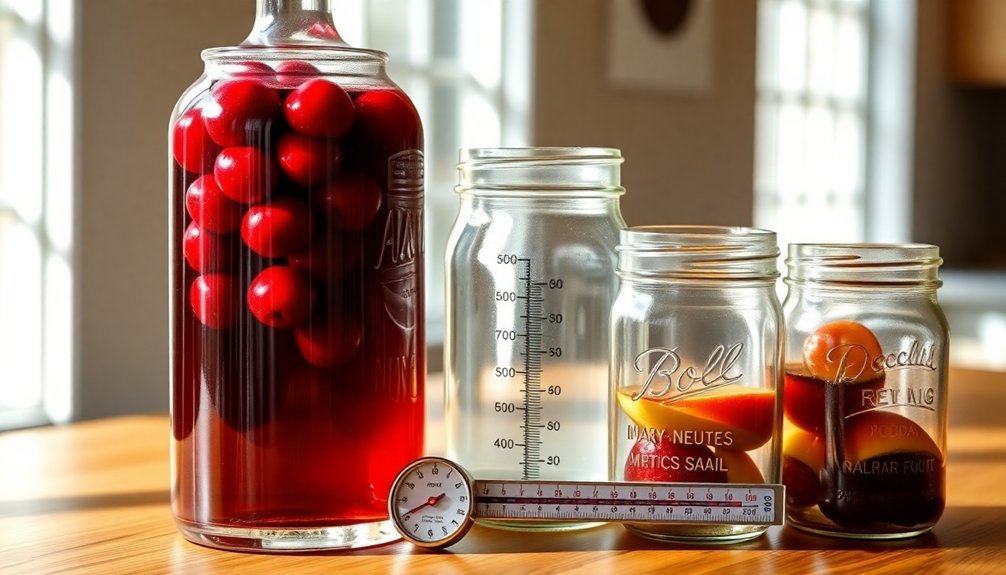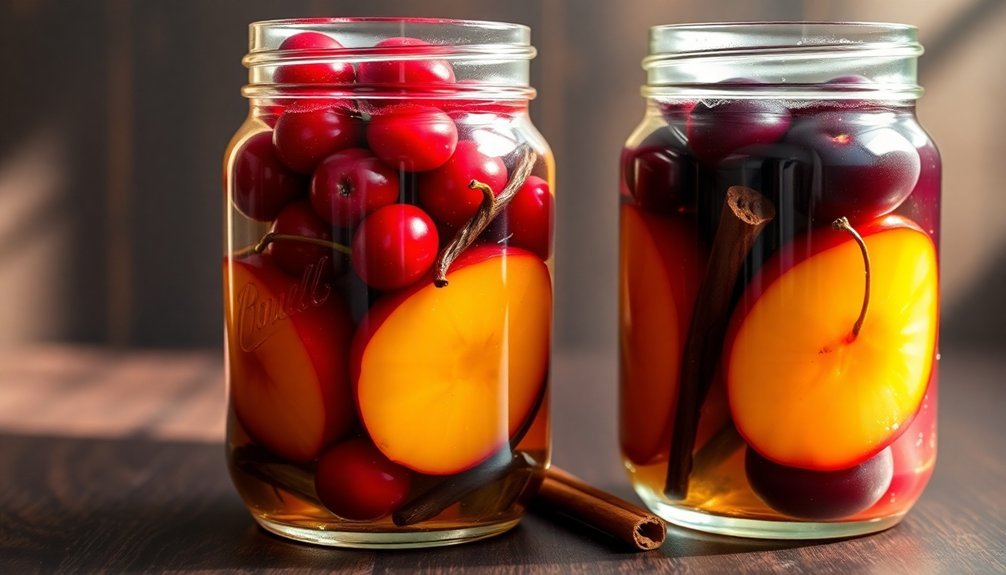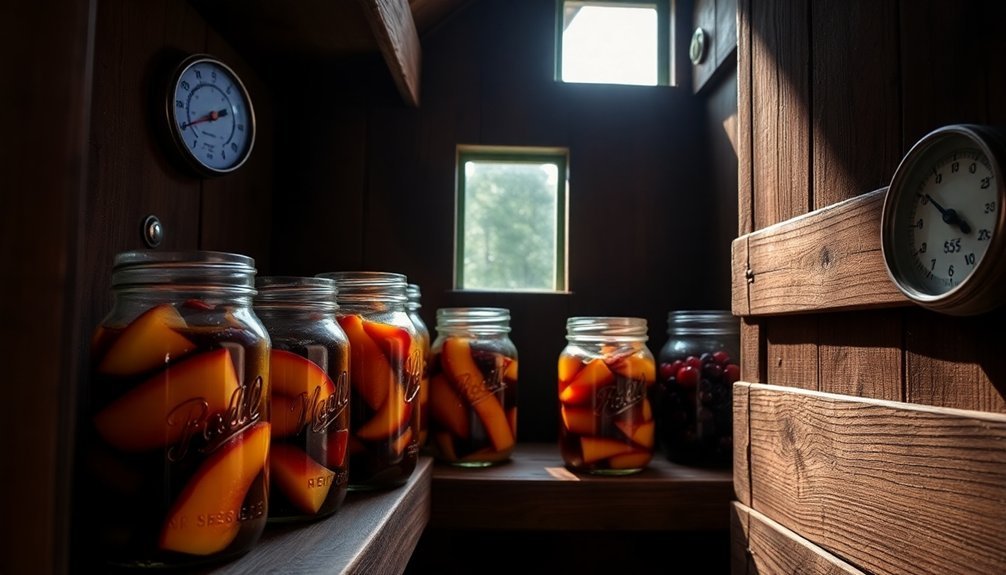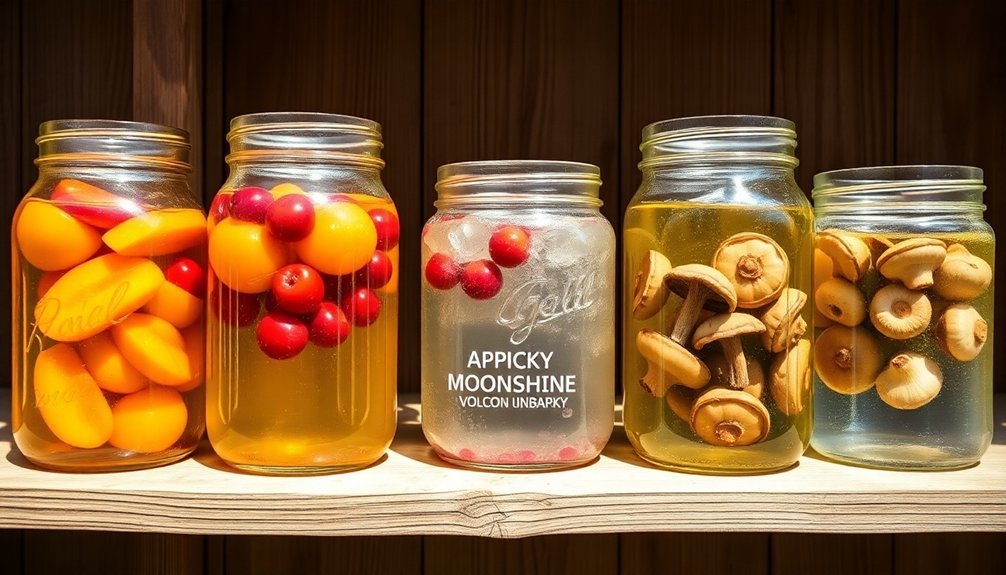For effective alcohol preservation at home, you'll want to start with spirits that are at least 35% ABV, with vodka being ideal for its neutral profile. Keep your preserved foods in sterilized glass jars stored at 55-60°F in a cool, dark place. You'll need to balance sugar and alcohol ratios, especially when preserving fruits – higher sugar for stone fruits, less for naturally sweet ones. Monitor temperature and humidity daily, and maintain proper ventilation. Always pre-sterilize your containers and avoid frequent checking during fermentation. Master these fundamentals, and you'll reveal a world of preservation possibilities that enhance both shelf life and flavor.
Selecting The Right Preservation Alcohol

Every successful food preservation project begins with selecting the right alcohol. You'll want to focus on spirits with a minimum 35% ABV to guarantee proper preservation and prevent bacterial growth. Vodka stands out as a top choice due to its neutral flavor profile, allowing your preserved foods to shine without competing flavors.
If you're looking to create more complex flavor profiles, consider using brandy, which pairs exceptionally well with preserved fruits and adds depth to homemade liqueurs. High-proof alcohol works best for extracting flavors from your ingredients while maintaining long-term stability. Using high-proof Everclear is particularly effective for maximum flavor extraction from fruits and herbs.
You can also experiment with flavored spirits to add complementary notes to your preserves. When choosing your alcohol, you'll need to balance preservation effectiveness with taste. While higher alcohol concentrations extract more flavors, they can sometimes overpower the natural taste of your preserved foods.
Consider adjusting the concentration based on what you're preserving and your desired outcome. Remember that distilled liquors are your safest bet, as they're more stable and less likely to spoil over time. Always store your chosen alcohol in a cool, dark place to maintain its preservative properties.
Essential Equipment For Alcohol Storage
Proper storage equipment stands at the heart of successful alcohol preservation. You'll need reliable refrigeration systems to maintain ideal temperatures, especially for beer storage. Walk-in refrigerators work best for large quantities, while glass door units provide easy access for smaller amounts, helping you prevent flavor degradation and maintain quality over time. Using sterilized glass jars similar to those used in traditional canning can provide excellent storage options for certain alcoholic beverages.
To protect your alcohol during storage, you'll want to focus on proper packaging and sealing methods. Use well-sealed containers and consider shrink-wrapping to guard against temperature fluctuations. Don't forget to implement tamper-evident packaging to guarantee freshness and prevent oxidation.
Your storage conditions must be carefully controlled. Keep bottles away from direct sunlight and maintain temperatures between 55-60°F. You'll need to store bottles upright and avoid humid areas that can damage labels and caps. It's crucial to track expiration dates and organize your inventory systematically.
For safe handling, you'll require sturdy equipment and trained personnel. Use furniture blankets to prevent damage during movement, and verify your storage setup allows for proper organization.
You should arrange bottles in a way that prevents metal cap rusting and enables easy access for rotation.
Fruit Preservation With Spirits

You can use your preserved fruit as dessert toppings, in baked goods, or sauces. The process of preserving fruit in alcohol delivers two edible products that you can enjoy in different ways.
The infused spirits work wonderfully in cocktails and punch.
Sugar And Alcohol Ratio Guide
When you're mixing sugar and alcohol for fruit preservation, you'll need to carefully measure both ingredients to achieve the right balance.
You'll want to add more sugar for stone fruits like peaches and plums, while naturally sweet fruits need less sugar to maintain their flavor profile.
Your mixture should maintain roughly 14% alcohol concentration to prevent bacterial growth while allowing the sugar to properly dissolve and enhance the preservation process.
Proper Sugar Measurements
Understanding sugar-to-alcohol ratios forms the cornerstone of successful home alcohol production. You'll need to calculate your sugar measurements precisely using the formula: desired volume × alcohol percentage × 17 grams of sugar per %.liter. For instance, if you're making 20L of 13% alcohol wash, you'll need 4.4 kg of sugar.
When using dextrose instead of regular sugar, increase your measurements by 25% – meaning you'll need 1.25 kg of dextrose for every 1 kg of sugar in your recipe. You can expect around 550 mL of pure ethanol from each kilogram of sugar you use, though actual yields typically reach 48% of the theoretical maximum due to fermentation losses.
To guarantee accurate measurements, you'll need to evaluate your yeast type. Baker's yeast can handle up to 14% alcohol content, while turbo yeasts manage up to 20%.
Keep your fermentation temperature between 20-32°C for ideal sugar conversion. For best results, dissolve your sugar or dextrose completely in water before adding yeast.
You can use a hydrometer to monitor your wash, but remember that residual sugar can affect readings, so calculate your ABV mathematically instead.
Balancing Sweet And Strong
Balancing sweetness with alcohol content requires precise calculations in order to achieve both ideal taste and desired strength in your beverages. You'll need approximately 17g of sugar for every 1% alcohol content per liter, making it essential to measure precisely when crafting your drinks.
To maintain balance, you'll want to take into account both the sweetness source and alcohol type. You can use sugar alcohols like xylitol or sorbitol to reduce calories while maintaining sweetness, though you'll need larger quantities compared to regular sugar. When using traditional sweeteners, remember that salt can enhance sweetness while reducing sourness.
| Alcohol Type | Sugar Needed (g/L) | Recommended Sweetener |
|---|---|---|
| Light Wine (10%) | 170g | Natural Fruit Sugar |
| Medium Beer (5%) | 85g | Dextrose/Malt |
| Strong Liquor (40%) | 680g | Sugar Alcohol Blend |
For long-lasting preservation, you'll achieve the best results by carefully monitoring your sugar-to-alcohol ratio. Keep track of fermentation efficiency, which can vary based on yeast strain and temperature. You can maintain control by alternating between full-strength and reduced-alcohol portions during the production process, ensuring consistent quality throughout your batch.
Maintaining Optimal Storage Temperature

You'll need to store your alcohol in a consistently cool environment between 55-60°F to prevent spoilage and maintain quality.
Controlling humidity is essential, so use a dehumidifier if necessary and make certain your storage area has proper air circulation to protect both the liquid and the bottle's integrity.
Check your storage temperature daily with a reliable thermometer, making adjustments as needed to maintain ideal conditions.
Cool Storage Prevents Spoilage
Throughout the storage process, maintaining proper temperature control stands as one of the most vital factors in preserving alcoholic beverages.
You'll want to keep your spirits at temperatures between 13°C to 16°C, while wines need slightly cooler conditions around 11°C to 14°C. For beer, you've got more flexibility, with acceptable ranges from 7°C to 16°C depending on the variety.
You shouldn't expose your bottles to extreme temperatures, as heat can cause expansion and evaporation, while freezing temperatures can degrade quality.
Once you've opened crème liqueurs or fortified wines, you'll need to store them in the fridge to maintain their integrity. It's important to keep your storage area away from heat sources and direct sunlight to prevent temperature fluctuations.
Daily monitoring is vital for maintaining ideal conditions. You'll want to use thermometers to check temperatures regularly and guarantee proper ventilation in your storage space.
Remember that consistent temperature control is key – avoid areas with frequent temperature changes. If you're storing bottles long-term, consider using protective measures like shrink-wrapping and corner boards to guard against temperature variations and potential damage.
Humidity Control Matters Most
Proper humidity levels work hand-in-hand with temperature control to protect your stored alcohol.
You'll want to maintain humidity below 15% in your storage area to prevent moisture-related problems that can damage labels, caps, and corks. Using fans for air circulation helps prevent dangerous moisture pockets from forming, while dehumidification systems remove excess moisture that could compromise your collection.
To maintain ideal conditions in your home storage, consider installing humidity control systems that match your specific needs.
Steam humidification offers precise control for larger storage areas, while evaporative systems work well for smaller spaces. You'll need to monitor humidity levels daily to guarantee your collection stays protected.
- Check bottle labels regularly for signs of peeling or deterioration, which indicate humidity problems
- Install air curtains near storage entrance points to keep moist air out and temperature-controlled air in
- Position centrifugal fans strategically to promote consistent air circulation throughout your storage space
- Use dehumidifiers during humid seasons to maintain safe moisture levels
Remember that proper humidity control isn't just about preservation – it's essential for maintaining compliance with food safety standards and preventing costly damage to your collection.
Monitor Temperature Daily
Three key temperature ranges define successful alcohol storage at home: 55-60°F for most spirits, freezing for vodka, and room temperature for short-term storage.
You'll need to monitor these temperatures daily to maintain ideal quality and prevent degradation of your spirits.
To protect your investment, keep your liquor away from areas with fluctuating temperatures, such as kitchens or garages.
These temperature swings can accelerate aging and diminish quality. Instead, choose a consistent storage space away from direct sunlight and heat sources.
You'll want to position temperature sensors in the warmest part of your storage area to get accurate readings.
While you don't need to refrigerate most spirits, maintaining stable temperatures between 13°C and 16°C (55-60°F) will help preserve their unique flavors and extend shelf life.
If you're storing vodka, you can keep it in the freezer, but this isn't necessary for other types of liquor.
Remember that extreme heat causes alcohol to expand and evaporate, affecting both flavor and quality.
Sterilization For Safe Alcohol Preservation
Understanding the limitations of alcohol sterilization is essential before attempting any food preservation.
You'll need to know that alcohol works best at concentrations between 60% and 90% in water, and its effectiveness drops considerably below 50%. While alcohol can denature proteins and kill many bacteria, it can't eliminate bacterial spores or penetrate protein-rich materials effectively.
For safe alcohol preservation, you'll need to combine alcohol sterilization with other methods to guarantee food safety. Remember that alcohol alone isn't FDA-cleared as a high-level disinfectant, and there's still a risk of food poisoning if not properly executed.
- Always pre-sterilize your containers using heat methods like steam or dry heat
- Maintain proper alcohol concentration by using a measured mix of water and alcohol
- Store preserved items in a cool, dark place to maintain effectiveness
- Monitor items regularly for any signs of contamination
If you're dealing with protein-rich foods or items requiring complete sterilization, consider alternative methods like heat processing or chemical sterilants.
The success of your preservation efforts depends on understanding these limitations and implementing proper safety measures throughout the process.
Common Mistakes To Avoid

Resist the urge to frequently check or test your products during fermentation. Each time you open the airlock or disturb the process, you risk contamination and spoilage.
Remember that proper sanitation of your equipment is non-negotiable – it's essential for preventing contamination and ensuring your preserved foods remain safe for consumption.
Frequently Asked Questions
Can Preserved Fruits in Alcohol Be Safely Consumed During Pregnancy?
You shouldn't eat alcohol-preserved fruits during pregnancy, as the alcohol content remains in the fruit and can harm your baby's development. Even small amounts of alcohol pose risks during pregnancy. Play it safe.
How Do Different Types of Alcohol Affect the Final Taste?
You'll find that different alcohols impart unique flavors: vodka's neutral taste preserves original food flavors, while rum adds sweetness, brandy brings fruity notes, and whiskey contributes rich, oaky undertones to your preserved foods.
What Happens if Preserved Fruits Float Above the Alcohol Level?
If your fruits float above the alcohol, they'll likely develop mold or spoil quickly. You'll risk ruining the entire batch due to bacterial growth. That's why you should always keep them fully submerged.
Can I Reuse the Alcohol After Consuming the Preserved Fruits?
Yes, you can reuse the alcohol after eating the fruits. Just strain it through cheesecloth to remove particles, check for any spoilage signs, and store it properly in an airtight container for future preserving.
Why Do Some Preserved Fruits Change Color Over Time?
Your preserved fruits change color due to chemical reactions like lipid oxidation and enzymatic browning. Temperature, light exposure, and oxygen levels during storage also affect color stability over time. You'll notice these changes gradually.
In Summary
You've now learned the essential methods for preserving food with alcohol at home. Don't forget to maintain proper sugar ratios, use the right spirits, and keep your storage area at consistent temperatures. By avoiding common pitfalls and following proper sterilization techniques, you'll create preserved treats that last for months. Remember, success comes from selecting quality ingredients and maintaining strict cleanliness throughout the process.





Leave a Reply